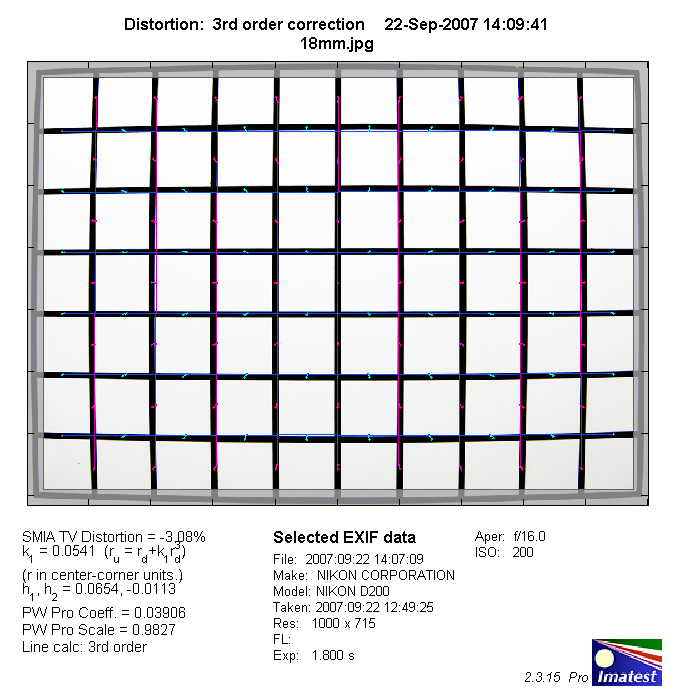|
Page 2 of 2

Distortion
Despite the DX crop the lens exhibits very pronounced barrel distortion at 18mm (~3.1%) which is a bit disappointing for an FX lens used on a DX camera, even for a wide angle lens. The problem eases continuously towards the long end of the zoom range. However, at 35mm there's still a moderate degree of barrel distortion left (0.8%).
|
Move the mouse cursor over the focal length text marks below to observe the respective distortion
|
| 18mm |
24mm |
35mm |
|

|
The chart above has a real-world size of about 120x80cm.
Vignetting
Thanks to its full format design the Nikkor AF 18-35mm ED produces little vignetting on a DX DSLR. There's only a moderate degree of vignetting at 18mm @ f/3.5 and at all other settings the issue is not field-relevant.

MTF (resolution)
This section has been updated since the review was published. We initially based our findings on a sample of the lens that unfortunately turned out to be out of specs. The findings below are based on a second sample that was reviewed later. Please see this thread in our forum for additional details.
The image center delivers very good to excellent resolution at all tested focal lengths. For maximum sharpness, the lens needs to be stopped down to f/5.6 or f/8.
At the widest setting, borders and corners lack both contrast as well as resolution wide open. Stopped down however the sharpness is very good even in the corners.
Zooming in, the border and corner resolution increases significantly when used with the largest aperture values. Again, stopped down the lens reaches very good sharpness here.
Please note that the MTF results are not directly comparable across the different systems!
Below is a simplified summary of the formal findings. The chart shows line widths per picture height (LW/PH) which can be taken as a measure for sharpness.
If you want to know more about the MTF50 figures you may check out the corresponding Imatest Explanations

Chromatic Aberrations (CAs)
The level of lateral chromatic aberrations (color shadows at harsh contrast transitions) is a bit disappointing for such a lens. At 18mm there are very obvious CAs peaking well beyond 3 px on the average at the image borders. CAs are less pronounced at 24mm but with values reaching up to 2 px still easily visible in high contrast scenes. Only at 35mm CAs are not really an issue.
However, CAs can easily be corrected in software or by the camera itself (most modern Nikon DSLRs remove CAs themselves if you shoot JPGs).

Sample Images
You can find some sample images taken with the Nikon D3x in our Nikon FX review of the lens.
VerdictThe Nikkor AF 18-35mm f/3.5-4.5D ED is capable of producing images with excellent resolution in the image center and very good sharpness across most of the image frame when shooting at and beyond f/5.6. However, the border and corner performance is far less impressive due to the lack of contrast and resolution when used wide open at the short end, a setting that should be avoided for shots that require good sharpness across the whole frame. For the rest of the aperture range, the lens performs quite well, but doesn't outperform dedicated DX zoom lenses.
The level of distortion is very high at 18mm, so it's not a lens that you'd want to use for serious architecture photography or any other subject with straight lines near the image borders. Vignetting is generally a non-issue whereas lateral CAs are very pronounced at 18mm (less so beyond). The build quality of the lens is fine for a consumer grade lens although it's nothing to rave about either.
All-in-all the lens had its time but there are simply better alternatives out there by now. In summary, any entry level DX kit lens gives better results for a lot less money.
|